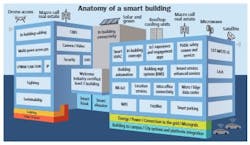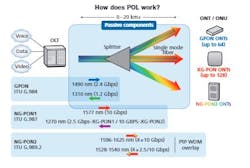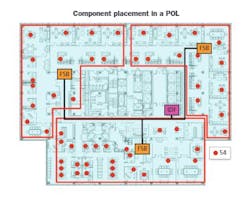How passive optical LANs can support smart buildings
By Limor Schafman, TIA and Joe Cook, Optical Cable Corporation
Smart buildings mean different things to different people, but as the definition evolves, we can all agree that it’s the interconnectivity and real-time data collection that makes a building “smart” and allows building owners and network managers to reduce costs as well as making buildings more energy-efficient and safer.
As buildings get smarter, the amount of data within the building is exploding. According to CTIA, a trade association that represents the United States wireless communications industry, monthly mobile data usage per SIM is at about 13 Gigabytes; by 2025, that is expected to grow to more than 98 GB—and that’s per SIM. (We often talk about data transmission in terms of Gigabits. Remember, a byte is 8 bits; a Gigabyte is 8 Gigabits.) Just consider population growth over that time and multiply by the number of uses, users, and number of Internet of Things (IoT) devices that will have SIM cards, and you’re looking at massive growth. A few more mind-boggling statistics: 82% of internet traffic will be IP video by 2021; and 75% of world traffic is video over mobile. Then factor in that 80% of mobile usage takes place inside a building.
Buildings are evolving into integrated ecosystems, and ultimately, the building as a service. Eventually, the building will become a fully digitized environment that is all about creating the experience. As illustrated herein, connectivity and telecommunications is fundamental to this success. It is in fact the fourth utility. To deliver on the expectations of in-building use, we need to build a significant infrastructure within our buildings. All this begs the question: is our infrastructure ready to support this?
The case for optical-fiber cable
The key to bringing this profound intelligence to the building is optical fiber, because it’s the only medium capable of delivering sufficient bandwidth to support current and anticipated usage. Although developers sometimes try to engineer fiber out—because it’s too expensive, or not necessary—tenants have fundamental expectations that only fiber can deliver.
When looking at fiber-based infrastructures for new installations, especially for buildings with a lot of functionality, people increasingly are considering passive optical LANs (POLs). For many years, building operators have installed fiber in their backbones and run copper cabling in the horizontal. However, to support a smart building, POLs can simplify network management while also providing more capacity and overcoming historical distance limitations encountered with a copper horizontal plant.One of the key advantages of a POL is that it’s passive. It’s not a “managed” component. POL is not a new technology; in fact it’s been successfully used in the telecommunications industry for fiber-to-the-home installations for decades, usually called passive optical networks or PONs. Passive optical LAN is the way a commercial business or a smart building would think about the very same technology, except inside the building. This allows the owner, or tenant, to leverage similar technology used by service providers to deliver a cost-conscious, reliable network solution over a futureproof infrastructure, allowing for greater operational efficiency and scalability. Another way to describe it: Fiber extends to the endpoint, desktop, device, or edge, which allows for greater bandwidth as well as remote powering for many devices.
POL vs. traditional LAN
How does POL compare to traditional LAN architectures? For the user, there is no difference. It’s standards-based and Ethernet-compliant. Compared to copper networks, and even hybrid fiber/copper LANs, the benefit that a POL brings to new construction include the following.
- A POL is point-to-multipoint, and that allows dynamic bandwidth allocation within the building, providing much more control and bandwidth utilization that is more efficient.
- Fewer devices are deployed and ultimately replaced in the network. Because there is no need for access and distribution layers in a point-to-multipoint architecture, there are fewer items to deploy (and replace) in your network, saving both initial cost and maintenance. Fewer devices also translates to lower power requirements, fewer points of failure and the ability to reduce HVAC loads from an opex standpoint.
- POL is scalable. The ability to eliminate or reduce closets and the reduction of Ethernet panels while still supporting a large and varied number of devices illustrate the scalability of the active components powering a POL.
- Smaller, lighter cabling bundles also allow building owners to repatriate some floor space.
- POLs use singlemode fiber, which has enough bandwidth to support upgrades for the lifespan of the building without recabling.
Note that a POL makes the most economic sense in greenfield construction; with an existing building, it’s not usually practical to reallocate the space taken up by closets, and full upgrade of the cabling infrastructure often is too costly. However, there are now products that allow building managers to leverage their investment in existing copper or multimode fiber and still get the benefits of a POL. Then, as cabling upgrades are required for new standards, singlemode fiber can be used to allow owners to futureproof that segment of the ongoing technology-refresh cycle.
How do passive optical LANs work?
As mentioned earlier, a POL uses fewer components than a traditional LAN. The main component is a centralized, Layer 2 switch called an optical line terminal (OLT). The OLT is connected to a router that connects to the internet or your other services. From there, the signal travels through a single strand of fiber from each port to an optical splitter.
Splitters divide the signal from one fiber strand into multiple, equal, fiber branches, commonly 1x32, but available in other configurations as well. The splits do not impact bandwidth, but will limit the power budget. Bandwidth management takes place in the management platform allowing quality of service and dynamic allocation to be specific to each user profile.
Optical splitters are small devices, only a couple of inches long and half-an-inch wide. They are housed in cassettes to protect them and then mounted in rack, wall, or ceiling enclosures—potentially reducing the need for different telecom spaces in new construction. Because they are passive devices, they generate little heat so they also reduce cooling requirements.
At the receiving end of the optical splitter is an optical network terminal (ONT), which connects to the end device, such as a printer, a computer, wireless access point, VoIP desk set or similar device. Because the optical splitters are passive devices, they save on power consumption and help reduce cost. While 1x32 is a common configuration, they are available in many sizes of 1x or 2x splits, allowing for an additional layer of network redundancy.
Unlike traditional fiber architectures, which use two strands of fiber—one to transmit, one to receive—passive optical LANs use a single strand of fiber to transmit and receive simultaneously over that single strand using different wavelengths of light.
The OLT is typically in the same rack as the core router. There are different sizes, ranging from 1U all the way to a large chassis-based version like the one depicted in the diagram. This is where the uplink card resides. The other cards also reside in the chassis but go out to the splitters via singlemode fiber. From there it goes to the different ONTs, which then commonly connect via copper category cable to the end devices. A GPON system, for example, would utilize two different wavelengths—1410 nanometers in downstream and 1310 in the upstream—over a single strand of singlemode fiber.
The flexibility of a POL means you can bring the connectivity to where it’s needed in the building, whether connecting a surveillance camera, a wireless access point, or a telephone. Essentially, you design the network backwards from the end user. The ONTs are placed in different locations depending on the devices they support, and the splitters are strategically placed in different locations to create zones. Then, a single strand of fiber runs back from the ONT to the OLT in the building. Because the cabling needs are dramatically less than in a traditional LAN, the pathways are also reduced. Heavy cable trays and large conduit are often replaced by smaller trays and J-hooks.
Consolidating Layer 1 infrastructure
Traditionally, with a Layer 1 environment, different devices had different requirements for disparate networks. Rather than breaking out individual devices, using a passive optical LAN enables consolidation of electronics. Each disparate network can now collapse onto a single fiber strand and then the network manager can break out functionality at the ONT for each networked device. A POL allows connection to anything that has an interface, whether Ethernet, IP, analog or coax. By supporting all these interfaces through a single device (OLT), it’s no longer necessary to build parallel networks with different cabling infrastructures.
Compared to using copper cabling to support these devices, the ability to use singlemode fiber offers tremendous advantages. The bandwidth capacity is finite and well-established in copper cabling types, whether it’s Category 5E, Category 6, or Category 6A. Even multimode fiber has bandwidth limitations, although they support far more data than copper cables. Singlemode fiber, however, has so much bandwidth capability that it’s mostly restricted by the ability of the electronics to transmit faster. Installing a singlemode infrastructure in a building provides futureproofing for decades.
A POL offers a much simpler network architecture than a more “traditional” network. As mentioned previously, splitters can be positioned in a variety of enclosures, including in a ceiling tile or a wall enclosure. Because POL can be delivered up to 20 kilometers (12 miles), the need for data closets is drastically reduced as well. This provides a shorter run to the devices. In fact, although standards were written requiring a telecom room for every 10,000 square feet, this was entirely due to the limitations of copper, versus the capabilities of fiber. When looking at new construction, it is possible to eliminate many traditional telecom spaces.The design of a POL is very simple. The first consideration is the ONTs. After this, the locations of the splitters are determined as well as proper positioning into fiber splitter boxes (FSBs). From there, a single strand of fiber would run from each splitter back to the OLT.
One commonly asked question about the POL design is whether the data from a packet sent from the OLT through the splitter gets delivered to every ONT connected to the splitter, or just to the destination. Here’s how it works: When a packet is transmitted out, it is multicast, so it is then only received by the person (profile) it was intended for. When the ONT transmits back to the OLT, it is time-division multiplexed, which means it uses a reserved time slot prioritized for that ONT to transmit back. In other words, downstream would be multicast, and the upstream would be time-division multiplexing.
Because a POL is, by definition, passive, one of the questions is how to power the IoT devices—phones, cameras, sensors, etc. There are two ways to power ONTs. The first is to run fiber passively to the ONT and then power the ONT locally, by plugging them into an outlet. Another option is for each ONT to be remotely powered from a central or distributed location, using a composite cable containing singlemode fiber and copper conductors with a Phoenix connector on the end. The connector plugs into the ONT and powers it remotely. Composite cable meets NEC Class 2 requirements, generally eliminating the need for conduit. Qualified telecom technicians can install composite cables. This results in a labor cost reduction that is applicable in both new construction or technology-refresh scenarios.
Is it cost-effective?
Even when designing a smart building, keeping costs down is still a top priority. When architects and building owners think of a fiber network, there’s still an assumption that the upfront cost is large. It’s sometimes not enough to say that the total cost of ownership of a fiber-based network is going to be lower than a copper network; building owners want to know that the upfront costs are also reasonable. Certainly, compared to even a few years ago, the cost of fiber-optic cabling has come down in price. Today, most cabling manufacturers offer preterminated cables allowing for a reduction in human error and installation cost. Factory-terminated and -certified cables are fast becoming a reliable, cost-effective solution.
POL using singlemode fiber results in fewer cables to install, and with pretermination and testing done at the factory, the network becomes plug-and-play in many respects. Couple these efficiencies with the reduction in power consumption and HVAC requirements, and the first-costs column is a win for the owner in more ways than one.
Looking at the trends driving bandwidth growth—software as a service (SaaS) apps, 4K video and the use of sensors in buildings to track so many different aspects of the building’s “nervous system,” fiber becomes a necessity. IoT and smart buildings are almost synonymous in the sense that what makes today’s building different than the ones from the 20th century is it has so many more devices inside. Buildings may have more humans too, and certainly those classic networks had a lot of users, but the number of devices is radically outpacing the number of users. Today, how you design a network is really more about the devices being used than the actual users in a building.
You don’t build a smart building for a lifespan seven years; you need to install an infrastructure that will allow it to get smarter over the coming decades. Even if you design your building today, it may take two or three years for the building to get built and commissioned. It’s important to know and deploy a cabling system that will make sure you are ready for the marketplace and the demands of your users today and can also grow with increased future demand. Not only does fiber support today; it will support anticipated future growth for a fraction of the equipment cost in traditional cabling, while protecting the building owner’s investment in smart technology.
Join the discussion
Developing smart buildings will give rise to smart campuses, which will foster smart communities and eventually smart cities.
Critical to achieving this growth is a common definition of what a “smart building” entails and a framework for ensuring connectivity, interoperability, communications and capacity.
In 2017, the Telecommunications Industry Association (TIA) launched its Smart Building Program to help unify the broader ecosystem of smart buildings. Earlier this year, Underwriters Laboratories (UL) joined TIA to help accelerate the development of a common framework for smart buildings, collaborating on a common portal to educate and inform stakeholders on the many aspects and solutions available to the smart-buildings market and laying the groundwork for an industrywide standard that will enable better connectivity, safety and reliability across smart-buildings projects.
TIA and UL will focus on benchmarking, measurements, assessments, certifications and registration in the areas of connectivity, interoperability, safety, and sustainability for buildings.
Companies interested in joining TIA’s Smart Buildings Program should contact co-author Limor Schafman at [email protected] for more information.
Limor Schafman is director of TIA’s Smart Building Program. She has presented around the globe about the program’s features and the practicalities of implementing it. Joe Cook is business development manager for optical LAN at Optical Cable Corporation.


